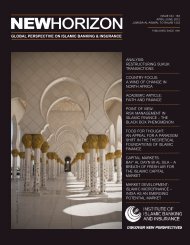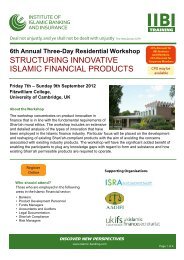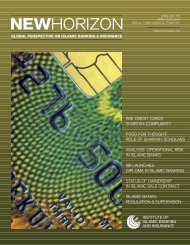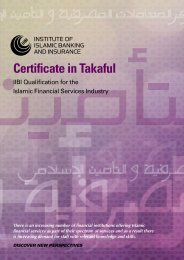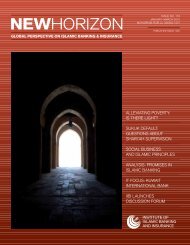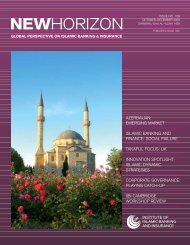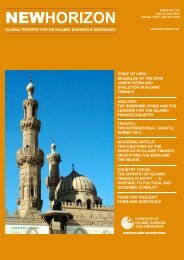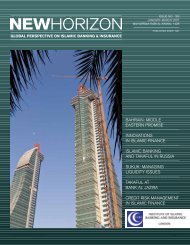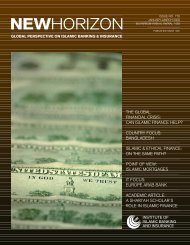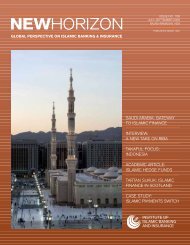NEWHORIZON
NEWHORIZON - Institute of Islamic Banking and Insurance
NEWHORIZON - Institute of Islamic Banking and Insurance
- No tags were found...
Create successful ePaper yourself
Turn your PDF publications into a flip-book with our unique Google optimized e-Paper software.
ACADEMIC ARTICLE<br />
<strong>NEWHORIZON</strong> October–December 2010<br />
❑ Rather, this is much more similar to the<br />
provision of a loan on interest, where the<br />
metal from Sale-1 is stored as a security<br />
against the stream of receivables relating to<br />
the deferred price in Sale-2.<br />
❑ Moreover, any necessity to physically<br />
move the ‘traded’ commodities in tawarruq<br />
from one location to another, as should be<br />
done, but is typically not done, would<br />
severely restrict the total volume and<br />
profitability of tawarruq transactions to the<br />
extent of eliminating the commercial<br />
feasibility of organised tawarruq altogether.<br />
As an added point, banks always organise<br />
the onward sale of the metal bought by the<br />
customer. This again is a violation of<br />
AAOIFI Shari’ah Standard 30.<br />
Thus having defined and implicitly agreed<br />
upon what tawarruq should and should not<br />
look like, AAOIFI and ICFA are well aware<br />
that the reduced profitability of doing this<br />
‘reformed’ version of tawarruq may well<br />
render it economically unfeasible to do<br />
tawarruq at all. Both institutions are quite<br />
comfortable with such an eventuality:<br />
‘either do it properly, or don’t do it at all’ is<br />
their combined implicit message to IIFSs.<br />
‘Movement’ of the Commodity/Metal<br />
Let us return to the question, ‘What does<br />
happen to the metal in reality?’<br />
There are certain parties who are active in<br />
the tawarruq sphere. These may be<br />
commodity trading companies who have the<br />
financial depth to hold reasonably large<br />
stocks of metal in their warehouses.<br />
Alternatively, they may be brokers, who<br />
have links with such trading companies and<br />
are also active in this market.<br />
With regard to tawarruq, the above parties<br />
act as buyers and/or sellers often in a large<br />
number of separate transactions and<br />
typically they operate a netting facility<br />
between their different storage facilities,<br />
whereby in reality metal either rarely or<br />
never really gets physically transferred from<br />
Seller 1 to Buyer 1, as it should. Typically,<br />
these parties possess a certain stock or<br />
quantity, e.g. ‘x’ tons of metal. Furthermore,<br />
these parties use and reuse this same stock<br />
many times during the same day in<br />
numerous consecutive sales. Almost exactly<br />
like the concept of fractional reserve<br />
banking in conventional banking, therefore<br />
these commodity stockers (for with regard<br />
to their tawarruq activities they are stockers<br />
more than traders) could hold one hundred<br />
tons of metal in their warehouse valued at<br />
$2.5 million and yet conduct tawarruq<br />
transactions amounting to any multiple of<br />
that, e.g. $25 or $50 million or even much<br />
more. Throughout these transactions, the<br />
metal would not need to move an inch.<br />
This is made possible, because each<br />
tawarruq transaction will normally have an<br />
implicit short holding period after which it<br />
is ‘released’ or ‘freed’. Thus, as an example,<br />
in a standard transaction:<br />
❑ 10.00am, September 10, 2010: Seller-1<br />
books four tons of aluminium for a deferred<br />
sale at $2,500 per ton to a customer for a<br />
$10,000 sale<br />
❑ 10.30am, September 10, 2010: The<br />
customer takes constructive possession but<br />
never sees the metal and may simply receive<br />
a certificate, usually indicating his<br />
consignment is placed in some named<br />
warehouse. At this point, Seller-1 ‘holds’ the<br />
four tons for the customer<br />
❑ 11.00am, September 10, 2010: The<br />
customer sells same aluminium to Buyer-1,<br />
for a spot price of $8,000; subsequently,<br />
according to the netting facility, four tons of<br />
aluminium are netted off between the<br />
storage facilities of Seller-1 and Buyer-1<br />
through some direct or indirect method,<br />
without the metal needing to physically<br />
move at all.<br />
This should make it clear that AAOIFI<br />
Shari’ah Standard 30 is not being followed,<br />
since a prior agreement or collusion agrees<br />
between the two parties Seller-1 and Buyer-1<br />
for such deals and effectively the metal does<br />
return back to the original seller as per the<br />
netting arrangement or rather, the<br />
ownership of the metal returns back; the<br />
metal itself, in actuality, never really moves.<br />
Incidentally, despite there being collusion<br />
between the Seller-1 and Buyer-1, which in<br />
effect contravenes Clause 4/5 of Standard<br />
30, the example given is actually a good<br />
scenario case in which, by implication,<br />
Seller-1 properly demarcates the four<br />
tons of metal in his warehouse to denote<br />
the customer’s constructive possession<br />
until Seller-1’s netting arrangement is<br />
finalised.<br />
In practice, however, it is doubtful whether<br />
such demarcation of the subject commodity<br />
occurs for each and every transaction, as it<br />
needs to do. Available evidence suggests that<br />
what typically happens is a daily or other<br />
periodic netting, in which, rather than<br />
specifically identifying and subsequently<br />
‘releasing’ the metal for each transaction,<br />
all the transactions for a certain day are<br />
carried out without such specific<br />
demarcation and hence even this minimal<br />
transfer of constructive ownership does not<br />
really happen in most cases. Daily net<br />
positions dictate the overall stock balances,<br />
i.e. how much is encumbered and how<br />
much is free to be used for new tawarruq<br />
transactions.<br />
The simple fact is that, in the absence of<br />
physical movement of the metal, it follows<br />
that tawarruq ‘traders’ would necessarily<br />
have to operate such a netting arrangement.<br />
It is one or the other; no third avenue is<br />
possible.<br />
Tawarruq: Quashing the ‘Justification’<br />
Arguments<br />
The defenders of organised tawarruq have<br />
put forward various arguments to justify<br />
why tawarruq should be allowed.<br />
Claim 1: Tawarruq traders often buy and<br />
sell metal with physical movement of the<br />
metal and hence that tawarruq is conducted<br />
by genuine traders.<br />
Reply: Although some movement of metal<br />
may happen, let us be clear about the<br />
circumstances in which it happens. The<br />
likelihood is that there are most probably<br />
only two scenarios in which the commodity<br />
moves:<br />
18 IIBI www.newhorizon-islamicbanking.com



